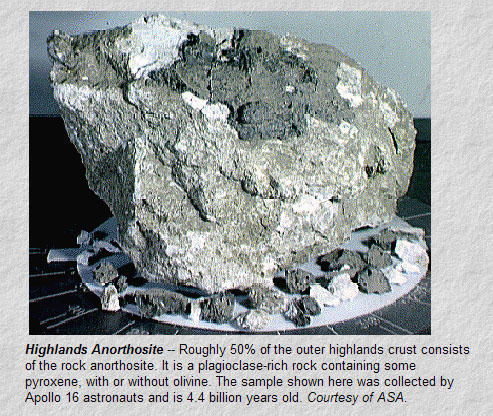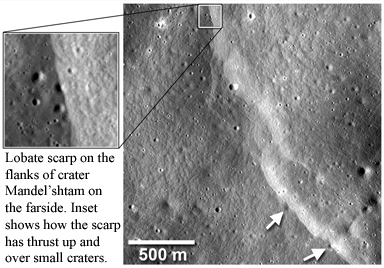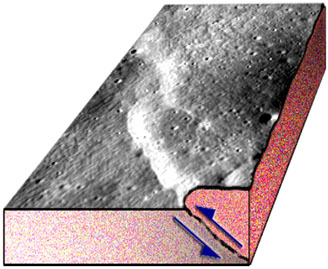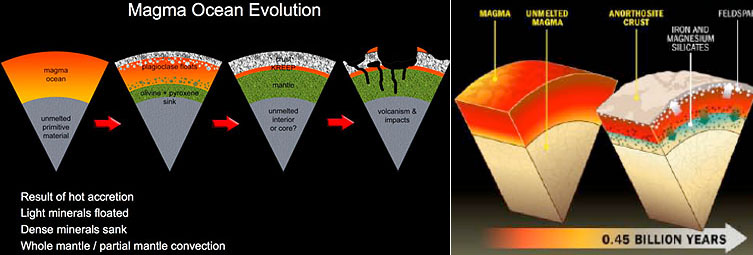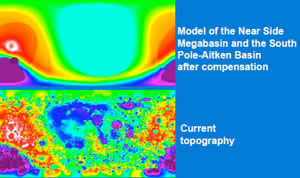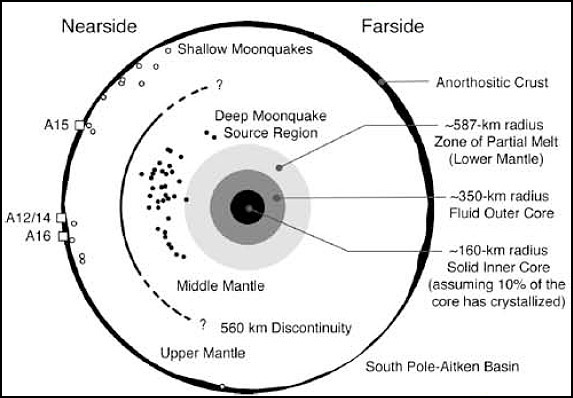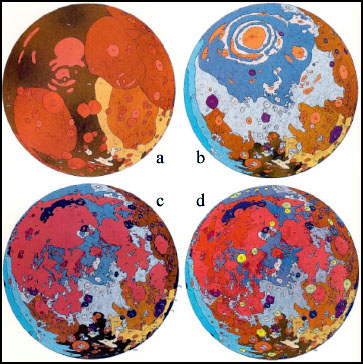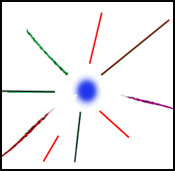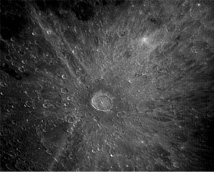Geological Nomenclature and Terminology
Contents
Geological Nomenclature & Terminology

Description
This page contains the more general usage of geological nomenclature, terminology and definitions applied to the Moon today. Note, while these may not be the full set of words and terms referencing the geological Moon, some additional, non-geologically-related words have been included to aid in their understanding. If other words or terms need to be included in this page, and/or, a clearer clarification needs to be added or made, please feel free to click the “Edit This Page” button above.
Alphabetical List
| A |
B |
C |
D |
E |
F |
G |
H |
I |
J |
K |
L |
M |
N |
O |
P |
Q |
R |
S |
T |
U |
V |
W |
X |
Y |
Z |
Bibliography |
A
Accessory mineral: A mineral that is present as small amounts in a rock but does not necessarily apply significance to a named igneous rock in general. When in small amounts, the accessory is usuallly referred to as a 'minor' accessory, while in larger amounts it is referred to as 'varietal' These minerals are characteristically formed during the solidification of rocks from magma.
Accretion:
Aeon: One thousand million years = 1,000,000,000 years = 10^9 years. - JohnMoore2
An Aeon is called a billion in the USA, but in UK a billion is only 10^8 years. What did Churchill say: The US and England were two great nations separated by a common language! - tychocrater May 24, 2010
Agglomerate:
Angular to sub-rounded pyroclastic rocks that are more than 64 mm in diameter, and related to volcanic vents and intrusive volcanic breccia environments.- JohnMoore2
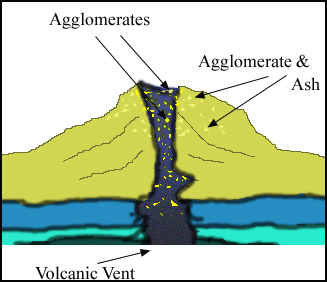
Credit: J. Moore
Agglutinates: Very small, individual aggregate particles commonly found in the lunar regolith soil. Ranging in size from tens of microns to a few millimetres in diameters, they form when tiny micrometeorites (< 1 mm) strike the regolith, producing a glassy fragment with sometimes other fragments of soil/rock becoming bonded within them. Trapped bubbles of gases from the solar wind (usually hydrogen) can also be found in agglutinates, while flow features are seen, too. Compositionally-wise, mare agglutinates differ slightly from those of the highlands’ agglutinates in that while the former are enriched in AL2O3 (Alluminium Oxide) and depleted in FeO (Ferrous Oxide), the latter are depleted in Al2O3 and enriched in FeO. About 50 % wt of agglutinates on average make up the lunar regolith. Image below shows an Apollo 11 sample of an agglutinate.
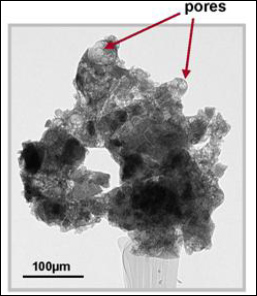
Credit: Adapted from An X-ray Ultra microscopy Study of Apollo 11 Lunar Regolith paper by Kiely, C and Kiely, C.J. (2010).
Aggregate:
Al-suite:
Anorthosite: Anorthosite is generally classed as an intrusive igneous rock containing a minimum of 90% plagioclase feldspar. Its occurrence on the lunar surface predominantly makes up the crustal highlands of the Moon; which is believed to have formed by the crystallization and floatation of plagioclase from a Magma Ocean that may have once globally covered the Moon. Image below shows Apollo 15 sample (15415) that was taken from the rim of Spur crater on the slope of Hadly Delta. Though not the oldest rock on the Moon, the sample became known as ‘Genesis Rock’, and was aged at approximately 4 billion years old. Composed of upto 98% calcic plagioclase, the rock may have formed through processes associated to the accumulation of plagioclase which makes up the lunar crust, however, its age is too young for it to have been produced from the original. - JohnMoore2
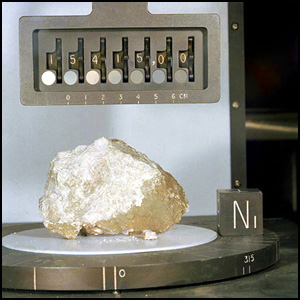
Credit: NASA
- Ferroan Anorthosite: An intrusive igneous rock containing more than 90% clacic plagioclase feldspar, that also has a Fe-rich composition. The ferroan anorthosites are the most common group of rocks of the highlands, and are thought to be original pieces of the lunar crust formed from the Magma Ocean. The ‘Genesis Rock’, mentioned above, is of the Ferroan Anorthosite classification; whose age has been calculated at approximately 4.4 billions ago. - JohnMoore2
- Cataclastic Anorthosite: Rock with a metamorphic Texture caused through crushing processes during its formation; showing a granular, fragmentary look (crystals under microscope show straining). Sample 60025 below showing little evidence of Texture. - JohnMoore2
- Anorthositic Norite:
ANT: Anorthosite, Norite, Troctolite.
Antipode: Points on the surface of a sphere that are located at either extremity of its diameter. As an example, the antipodal point of the lunar North Pole is the lunar South Pole.
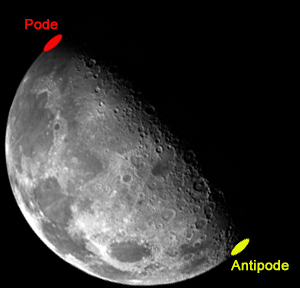
Credit: NASA
Apennine Bench Formation: See Apennine Bench.
Aphanitic: See Texture.
Arcuate: Arc-like, or bow-like, curved feature. See also Arcuate rille below as an example.- JohnMoore2
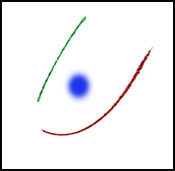
Credit: J. Moore
Ash: A deposit of very fine-grained fragments smaller than 2 mm in diameter. The ash is generally made up of glass shards, broken crystals, and lithic rock – pieces of other rocks. - JohnMoore2
Ash-flow:
Asymmetrical crater: Asymmetrical craters are usually non-circular, and take on a more elongated shape. Formation of such craters may be due to impactors that struck the lunar surface at low, oblique angles producing a gouging type of event, or these craters may be due to overlapping of several craters together. Example – Messier crater. See also Atypical crater and Crater Types below. - JohnMoore2
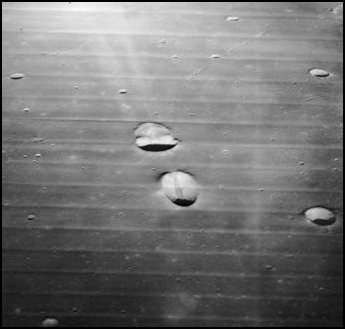
Credit: NASA
Atypical crater: See also Asymmetrical crater above and Crater Types below.
Augite:
To Top
B
Banding:
Basalt: High-Ca pyroxenes (>50%). Image below shows Apollo 17 sample (70017) of a ilmenite basalt taken not far from the Lunar Lander. - JohnMoore2
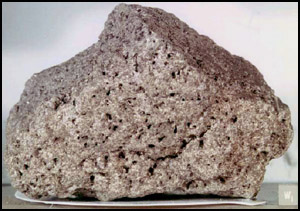
Credit: NASA.
- Hi-Al (High Aluminium) Basalt: Rocks that have approximately 40 to 60% Plagioclase. These rocks are low in Calcium Pyroxene with Olivine inclusions. Such alkali rocks may be considered compositionally equivalent to KREEP-type basalt rocks. The geochemistry of Hi-Al basalts indicate that they may be derived from sources composed of late-stage cumulates of the Magma Ocean, while radiometric dating of these rocks also suggest that aluminous basaltic volcanism spanned over a period of 1 billion years that occupied a unique compositional location in the Th-FeO (Thorium-Ferrous-Oxide) domain. See also Kramer et al article below (2008) in the Bibliography. - JohnMoore2
Base surge:
Basin:
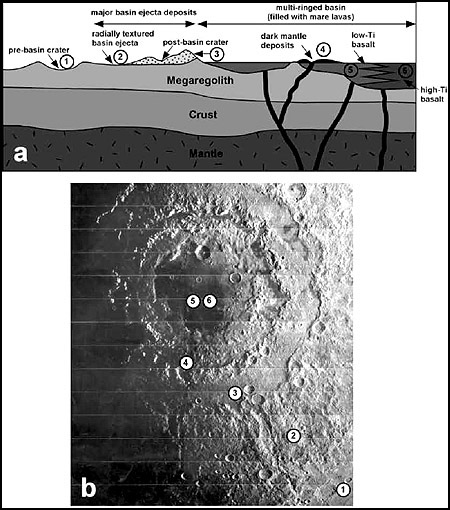
Credit: Adapted from Moon 101 (Pdf file) by Paul Spudis.
Basin Materials:
Bedrock:
Bombardment Period:
Boulder tracks: Image below shows boulder tracks produced by a 10 metre-wide rock as it rolled down the inner, sloping side of a small crater that lies within Henry Frères crater (Lat: 23.5°S, Long: 58.9°W). Boulders usually start off on the ridge or rim of a crater until they become disturbed by an external vibrational source, such as, an impactor striking the surface nearby or through moonquakes. The moon’s 1/6 gravity (to that of Earth’s) allows the boulders to bounce and bounce for quite a distance depending upon the angle of slope that they are rolling down, and from the tracks left it is possible to calculate how fast they were moving at the time. - JohnMoore2
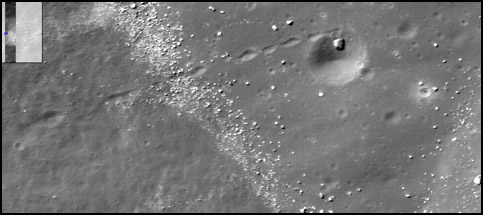
Credit: LROC
Breccia:
Breccias are rocks composed of older rocks whose makeup can contain anything from a mixture of basaltic mare fragments to highland rocks of anothositic nature. The breccias are predominantly found in the highland regions of the Moon, and are classed as the lithified aggregates of clastic debris and melt generated by meteorites striking the lunar surface. Estimated to have formed about 3.9 billions years ago during a period of heavy bombardment, most of the breccias are thus mixtures of a single impact or many impacts (polymictal) – the results of which show up as craters on the Moon.
Like many of the rock types found on the Moon, the varieties of breccias produced have been given classifications according to their formations. For example, there are the Fragmental breccias, the Glassy-melt breccias, the Crystalline-melt breccias, the Clast-poor impact-melt breccias, the Granulitic breccias, the Regolith breccias. Worth mentioning is the dimict breccias, which are a relatively rare lunar rock type consisting of dark impact melt material with a high-Al content, and a lighter anorthositic composition that has been crushed or shattered (cataclastic). They usually form in basement rocks of large craters which have been forcibly injected into hot-shocked rocks containing dike-like veins. The main constituent, however, for all of the lunar breccias is that they have a high Al content due to the abundance of plagioclase -- found in the highland regions. See also this PDF file on Lunar Breccias. Image below shows Apollo 16 sample (16015) of a dimict breccia –– taken some 10 metres from Plum crater (see Petrology and Geochemistry of Lunar Dimict Breccia 61015). - JohnMoore2

Credit: NASA (Photo). Graphic: J. Moore.
Breached crater: See also Crater Types.
Buried crater: See also Crater Types.
To Top
C
Calcic: Containing calcium (Ca).
Caldera: A crater-like, volcanic feature that results from the collapse of the magma chamber beneath the volcano. Some craters on the Moon have a caldera look to them (controversial), however, some examples include: Hyginus crater. See also Volcano types. - JohnMoore2
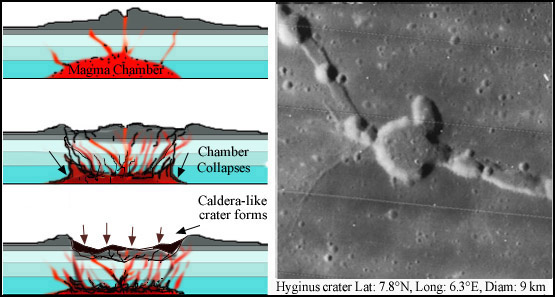
Credit: J. Moore, NASA (Photo).
Capture Model: See Formation of the Moon.
Carbonaceous material:
Cataclastic: Crushed and shattered rock. - JohnMoore2
Cauldron Resurgence:
Cayley Formation: See Cayley Formation.
Central peak:
Clastic:
Clasts:
Clinopyroxene: High-calcium content rocks. Roughly, 5% of clinopyroxene rocks can be found in the highland (anothositic) regions, while in the lowland (basaltic) regions a more mafic mafic clinopyroxene type is seen. Examples of clinopyroxenes would be Augite and Pigeonite Pigeonite, and most are common in mare basalts [Ca(Mg,Fe)Si2O6]. See also orthopyroxene rocks and pyroxene rocks below. - JohnMoore2
Co-accretion Model: See Formation of the Moon.
Cold trap:
Collapse crater: See also Crater Types and Calderas.
Complex crater: Complex craters are generally more larger than the more common simple crater, and can range in size anywhere from ~ 20 to 175 km in diameter. Characteristics of such craters show up as having relatively flat floors with some hilly or mound material inside, and more often than none a central peak will also reside. The inner walls may show some slumping that leaves behind single or multiple blocks about those regions, while at the rim areas circumferential failing of material there can produce a series of terraces (sometimes in-filled with impact-melt deposits). Rim topography takes on a more scalloped, irregular look, and on the exterior side of this the terrain is usually: elevated (about half a crater radius away); rugged about the rim circumferentially; and the material here may consist of deep interior deposits of the crater floor region as well as that of resultant ejecta. Depth-to-diameter ratio for the relatively smaller complex crater is about ~ 1:5, while for the larger types it is approximately ~ 1:40. Example – Tycho. See also Transitional craters and Crater Types below. - JohnMoore2
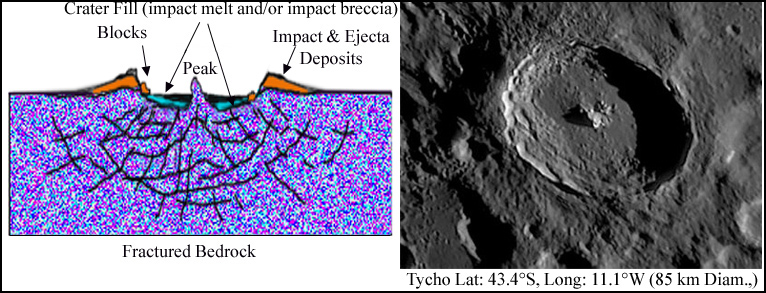
Credit: J. Moore, Steve Bryson (Photo)
Composition of the Moon:
Compression:
Concentric: A feature that is, roughly, circularly-centred to another feature. As an example, see Concentric rille below. - JohnMoore2
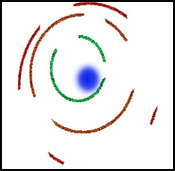
Credit: J. Moore
Concentric crater: See also Crater Types.
Cones:
Copernican Period: 1.1 billions years ago to Present. See Stratigraphy.
Core: Maximum radius ~ 400 km.
Crater:
- Impact:
Impact craters, in general, are produced from the result of an object (e.g. asteroid, comet, meteorite, rock, block...etc.,) striking the surface during a hypervelocity (over 3000 m/s or 11,000 km/h) collision. As the object makes contact with the surface (usually referred to as the Target Rock), high-pressure Shockwaves propagate through both object and target; producing a series of expanding wave-fronts and decompression (rarefactions) effects that move downwards and outwards. These set in motion particulate velocities of the material mix to reach speeds greater than that of sound (~ 340 m/s in a solid medium); producing a melted and vaporised volume around the impact zone (NB: sound cannot travel through a vacuum like there is on the Moon, so this speed here is given merely as an example to the velocities involved). Only when the tensile strength of the target rock overcomes the power of the shock waves and decompression effects, does the whole impact crater formation process cease.
The shock waves are orders of magnitude above the strengths of both bodies during the impact event, and the whole system behaves hydrodynamically (fluid-like). As a result, the material mix is jetted out parallel to the expanding cavity wall at roughly 40 to 60 degrees above the horizontal, producing a 'curtain' of ejecta which continuously decreases in height while expanding in diameter. Excavation of material is not predominantly due to the shock waves involved, but rather the decompressive effects induced as a result of them. While the waves eventually decay due to factors like: the original kinetic energy of the impactor; the penetration depth; and the duration of contact, cavity growth stops however, but the remaining material in the curtain continues for a considerable period afterwards. This thrown-out material ouside the crater's rim thins in deposit the further from where it lands, and it's stratigraphic sequence is important because deep layers now lie deposited in reverse order (see Ejecta image below). In some instances where the impact is extreme, Secondary cratering and Rays may also result -- due to the ejecta material launched first at the highest velocities, and in the longest trajectories near the impact zone.
The general picture of impact crater formation is, thus, very complex, and can vary according to their final formation and types -- .e.g. simple, complex or basin (based on the factors mentioned above e.g. size of impactor, its KE, object and target rock make-up...etc.,).- JohnMoore2
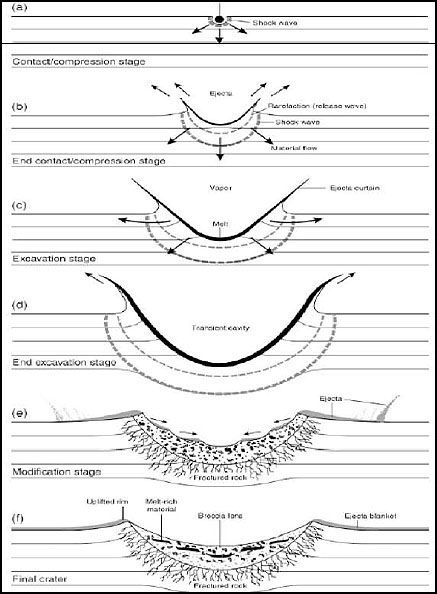
Credit: Adapted from Moon 101 (Pdf file) by Paul Spudis.
- Volcanic:
See also Crater Types, Crater catalogs, Crater classification.
Crater chain: See also Crater Types
Crater classification: See Crater classification.
Crater ejecta:
Cratering rate (frequency):
Craterlets:
Crater materials (deposits):
Crater ray: See also Rayed crater
Crater Types:
- Asymmetrical: See also Asymmetrical crater
- Atypical: See also Atypical crater
- Breached: See also Breached crater
- Buried: See also Buried crater
- Chain: See also Chain of craters
- Collapsed: See also Collapsed crater
- Complex: See also Complex crater
- Concentric: See Concentric craters on the Moon
- Dark-halo: See also Dark-haloed crater
- Delta-rim: See also Delta-rim crater
- Endogenic: See also Endogenic crater
- Floor-fractured: See also Floor-fractured crater
- Ghost: See Ghost crater
- Hexagonal: See also Hexagonal crater
- Irregular: See also Irregular crater
- Nested: See also Nested crater
- Partially-buried craters: See Partially-buried craters
- Primary: See also Primary crater
- Rayed: See Rayed crater
- Secondary: See also Secondary crater
- Simple: See also Simple crater
- Tilted: See also Tilted crater
- Transitional: See also Transitional crater
- Volcanic: See also Volcanic crater
Crust: The lunar is about 50 km thick on the Nearside and 80 km thick on the Farside.
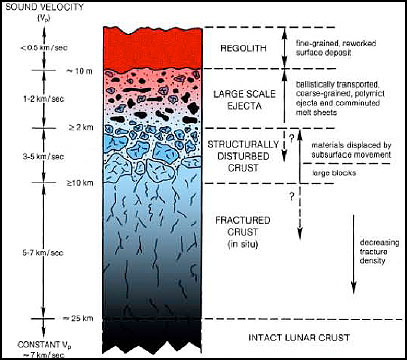
Credit: Adapted from Moon 101 (Pdf file) by Paul Spudis.
Cryptomaria:
Cumulus: See Texture.
To Top
D
Dark-haloed crater: Craters with a dark material to their surrounds – the appearance of which is due to underlying dark deposits (e.g. dark basalts) having been excavated from beneath and ejected onto a lighter, upper surface such as younger ray deposits and other brighter materials. See also Crater Types. Examples: Buch B, Copernicus H. - JohnMoore2
Dark-mantle material (deposits):
Debris:
Deformation:
Delta-rim crater: See Crater Types.
Density of the Moon:
Depth-diameter ratio (d/D) for craters: Simple craters ~ 1:5, Complex craters ~ 1:5 (for small complex craters) and 1:40 (for the largest). See also Crater Types. - JohnMoore2
Differentiation:
Dike (Dyke):

Credit: J. Moore
Dip-Slip (fault): When the direction of the fault-plane is parallel to the dip of the fault. Note how the Normal Dip-Slip fault compares to the Reverse Dip Slip fault. See also Strike-Slip fault. Examples -- Rupes Recta (Straight Wall), Rupes Toscanelli. - JohnMoore2

Credit: J. Moore, Wes Higgins (Photo).
Dimict:
Dome: See Domes and Lunar Volcanoes.
Downslope:
Dunite: Pure Olivine.
To Top
E
Ejecta: Material which is explosively thrown outwards and upwards as an impact occurs. Note, the thrown material which settles as an ejecta-blanket from and near the rim, deposits in reverse stratigraphic order, that is, deeper (and older) crater material will overlie upper-layer (younger) material. - JohnMoore2

Credit: J. Moore
Emplacement:
End-member: The end in a series of mineral samples with similar crystal structure approaching extreme purity. Two or more pure chemical compounds that enter into solid solution (a solvent that remains unchanged by addition of solutes) with other pure chemical compounds can make up this type of mineral. For example, Plagioclase feldspar changes progressively from end-member Albite (NaAlSi3O8) right through to intermediate members, such as, oligoclase, andesite, labradorite, bytownite, to end-member Anorthite (CaAl2Si2O8). The same applies to, for example, Olivine ((Mg,Fe)2SiO4)) which has an intermediary composition between end-member Fosterite (Mg2SiO4) that changes progressively to Fyalite (Fe2SiO4).- JohnMoore2
Endogenic crater: See Crater Types.
Epoch:
Eratosthenian period: 3.15 to 1.1 billion years ago. See Stratigraphy.
Escape velocity from Moon: ~ 2.4 Km/sec.
Excavation:
Extrusive:
To Top
F
Facies:
Fallback:
Farside:
Fault:
- Dip-Slip: See Dip-Slip fault.
- Strike-Slip: See Strike-Slip fault.
Feldspar:
Felsite:
Fire fountain (Volcano):
Fission Model: See Formation of the Moon.
Fissure:
Floor-fractured crater: See Crater Types.
Formation of the Moon:
- The Capture Model:
- The Fission Model:
- The Co-accretion Model:
- The Giant Impact Model:
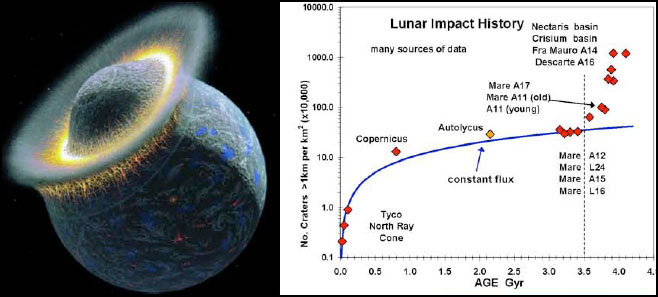
Credit: Adapted from Moon 101 (Pdf file) by Paul Spudis.
Fracture:
Fra Mauro Formation: See Fra Mauro Formation.
To Top
G
Ga:
Gabbro: High-Ca pyroxene.
Gabbronorite:
Gargantuan basin: See Gargantuan Basin.
Ghost crater: See Crater Types.
Giant Impact Model: See Formation of the Moon.
Glacies: The mound of material directly outside a crater's rim. - JohnMoore2
Glass:
Graben: When the rock or region sinks down between two, or several faults lying parallel to each other. See also Rille. Example: Rima Ariadaeus. - JohnMoore2

Credit: J. Moore, Mick Hyde (Photo).
Granite:
Granoblastic: See Texture.
Granulithic: See also Texture, and Granulithic Troctolite.
Graphite Whiskers: An allotrope (a variant of a substance consisting of only one type of atom) of carbon produced by high-temperature processing as calcium aluminium inclusions in space (e.g. relatively close to the Sun and early in the condensation sequence of protoplanetary disk materials). See recent Science article – July 2010 on discovery of graphite whiskers within Apollo 17 lunar sample 72255 below (an Impact Melt Breccia having an Aphanitic texture). - JohnMoore2
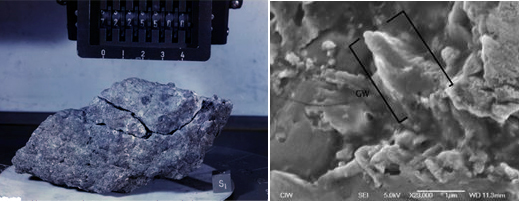
Credit: Left: Lunar sample No. 72255 from LPI. Right: Scanning electron microscope image of a Graphite Whisker (GW) seen in the Allende meteorite (Science/AAAS).
Gravity anomaly:
To Top
H
Haloed-crater: See Crater Types.
Helium-3:
Herringbone pattern:
Hexagonal crater: See also Crater Types.
Highlands:
High-Al:
High-K:
Hi-Ti: High Titanium. Hi-Ti basalts, for example, were deposited between 3.85 and 3.55 billion years ago during the Lower Late Imbrium period (low titanium basalts, on the other hand, were deposited between 3.45 to 3.15 billion years ago during the Upper Early Imbrium period (see Stratigraphy). - JohnMoore2
HKFM: High-potassium (K) material of the Fra Mauro basalt (see also MKFM, LKFM). - JohnMoore2
To Top
I
Igneous:
Ilmenite:
Imbrium Period: 3.85 to 3.15 billion years ago. See Stratigraphy.
Impact melt: Rocks that have been melted by the dynamic processes involved during the hypervelocity impact of large objects like meteorites, asteroids and comets onto the lunar surface. Other rocks like breccias and clastic types once believed to be volcanic in origin are now known to have been impact-produced. Impact processes such as these may also be useful for gaining additional information about ancient carbonaceous material that was delivered to the Moon during the Late Heavy Bombardment period. In larger impacts, for example, like the South Pole Aitken basin, deposits found in the central peaks of fresh craters within may be the relic-makeup of a gigantic impact melt pool that was created during the basin’s formation. For more on the dynamics of impact melt and some great LROC images, see B. W. Denevi’s (et al) paper in Bibliography below. The LROC image below shows the forking of impact melt flows (not volcanic flows) from a source crater ENE of Mare Moscoviense. - JohnMoore2
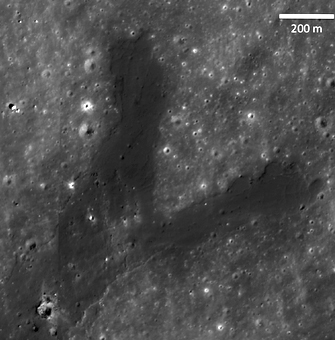
Credit: LROC.
Impact rate:
Infill:
Intersertal: Fine-grained minerals in small openings or crevices (interstices) of larger crystals. - JohnMoore2
Intrusion:
Intrusive:
Irregular crater: See Crater Types.
Isotopes:
To Top
J
Jets:
To Top
K
Kipuka (or Steptoes): Zone of avoidance (described in Peter Schultz's book Moon Morphology).- DannyCaes May 24, 2010. Image shows a series of kipuka (arrowed) -- representing the subsurface rims and terra of an area east of the crater Letronne and southern Oceanus Procellarum.
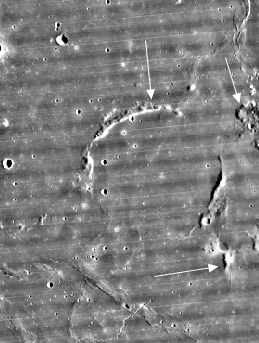
Credit: Lunar Orbiter view from Map-A-Planet.
KREEP:
- urKREEP:
To Top
L
Laccolith:
Landslide:
Late Heavy Bombardment:
Lava:
Layering:
Lineaments:
Linear: A feature with a somewhat straight appearance to it. See Linear rille as an example. - JohnMoore2
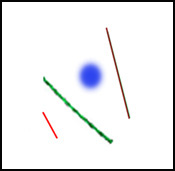
Credit: J. Moore
Lineate:
LKFM: Low-potassium (K) material of the Fra Mauro basalt (see also HKFM, MKFM). - JohnMoore2
Lobate scarp: A stair-step-like feature resulting from a reverse thrust fault where one side is thrust upwards and over another side. The scarp then takes on the look of a slanting wall that can be 100’s of metres high and 100’s kilometres long. Usually, scarps have no preferred orientation and so their appearance can be sinuous to arcuate in form; with the scarp face side sometimes steep and the sloping back side more gentle. Upto 70 lobate scarps around the lunar equator were photographed during the Apollo 15, 16 and 17 missions, however, recently 14 new scarps (see Science 20 Aug 2010) have been found across widespread regions of the Moon in high-resolution images from the Lunar Reconnaissance Orbiter, for example, in a most recent discovery of a scarp within Slipher crater. See also Dip-Slip fault.
Image below shows a lobate scarp on the flanks of Mandel’shtam crater.
Credit: NASA/Goddard/Arizona State University/Smithsonian (Photo), J. Moore (graphic)
Lowlands:
Lower (Late) Imbrium Period: 3.85 to 3.75 billion years ago. See Stratigraphy.
Low-Ti: Low Titanium. Low-Ti basalts, for example, were deposited between 3.4 and 3.15 billion years ago during the Upper Early Imbrium period (high titanium basalts, on the other hand, were deposited between 3.85 to 3.55 billion years ago during the Lower Late Imbrium period (see Stratigraphy). - JohnMoore2
To Top
M
Mafic:
Magma:
Magma Ocean:
Credit: Left: Jeff Plescia, Right: Adapted from Moon 101 (Pdf file) by Paul Spudis.
Magnetic field:
Main sequence of craters:
Mantle:
Mantle deposits:
Mare:
Mare Basalt:
Mascon:
Massif:
Maturation:
Maunder Formation: Named after the unrelated Maunder crater that lies on the north floor of Orientale basin (the Formation lies between Mare Orientale and the outer Rook ring). - JohnMoore2
Megaregolith:
Megabasin: Sometimes called the ‘Near Side Megabasin (NSM), its central location is (according to Charles Byrne at Lat 8.5N, Long 22.0E (approximately in the western part of Mare Tranquillitatis. This proposed basin has a major axis of 3320 km-wide and a minor axis of 3013 km-wide, with a scale depth of 4000 m and mare level of -1700m. Image below show the region of the megabasin.
Credit: Charles J. Byrne
Metamorphic:
Metamorphic:
Mg-suite:
Mineral:
Mixing:
MKFM: Medium-potassium (K) material of the Fra Mauro basalt (see also HKFM, LKFM). - JohnMoore2
Moonquakes:
Credit: Adapted from Moon 101 (Pdf file) by Paul Spudis.
Morphology:
Multi-ringed basin:
To Top
N
Nearside:
Nectarian Period: 3.92 to 3.85 billion years ago. See Stratigraphy.
Nested crater: See Crater Types.
Norite: Plagioclase feldspar, low-Ca pyroxene. - JohnMoore2
To Top
O
Oblique (Impact):
Olivine: Pure olivine is called dunite and lesser amounts are referred to as troctolite. - JohnMoore2
Ophitic: See Texture.
Ore deposits:
Orthopyroxene: Low calcium content pyroxene rocks -- the most common found with norite in them. - JohnMoore2
Oxides: Example – Ilmenite:
To Top
P
Paleogeological:
a: Before Imbrium Basin (~ 3.9 Gya), b: Just after Imbrium Basin (~3.85 Gya), c: Just after most mare flooding (~3 Gya), d: Present moon. Descriptions a, b, c and d were taken from the below-mentioned Pdf file – credit Paul Spudis.
Credit: Adapted from Moon 101 (Pdf file) by Paul Spudis.
PAN: Pure ANorthosite: See Anorthosite.
Partially-buried craters: See Crater Types.
Petrology:
Phenocryst:
Pigeonite:
PKT: Procellarum KREEP Terrain.
Plagioclase:
Plains:
Plutonic:
Poikilitic: See Texture.
Poirpheritic: See Texture.
Polymict:
pre-Nectarian Period: 4.6 to 3.92 billion years ago. See Stratigraphy.
Primary crater: See Crater Types.
Pristine rocks:
Promontory:
P-Waves:
Pyroclastic:
Pyroxene: (see also Clinopyroxene and Orthopyroxene).
To Top
Q
Quartz:
To Top
R
Radial: A characteristic feature that appears to radiate away from a point that sometimes resembles a spoke-wheel. As an example, the rays around crater Tycho radiate away from its central regions.- JohnMoore2
Credit: J. Moore (graphic). Howard Eskildsen's Photo from the LPOD Photo Gallery.
Rampart:
Rays:
Rayed crater: See Crater Types.
Regolith:
Ridge:
Rille (see also List of Lunar Rilles, Rima, Graben.
- Arcuate: Flat-floored, steep-walled troughs consisting of a floor a few kilometres wide. These type of rilles are Grabens created by extension of the surrounding terrain and rock. Example -- Rimae Hippalus. - JohnMoore2
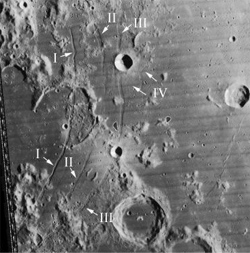
Credit: Lunar Orbiter view LO-IV-132H.
- Concentric: Example -- Rimae Pitatus.
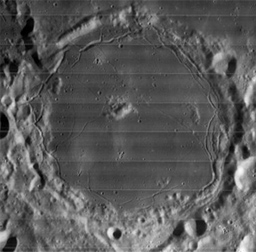
Credit: Lunar Orbiter view LO-IV-119-H3.
- Linear: Believed to form in a Graben type of situation whereby the region of rock sinks down between two parallel faults. Although considered as straight features, the terrain on which they form usually results in them having slight curves, offsets, and deflections. Example -- Rima Agatharchides. - JohnMoore2
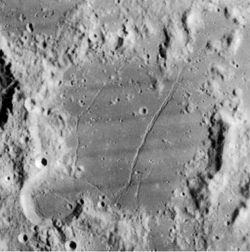
Credit: Lunar Orbiter view LO-IV-132H.
- Sinuous: Possibly, lava channels that erosionally incises the terrain they flowed on, or they could be the result of collapsed lava tubes where at one time molten lava flowed through. The meandering nature of these rille types usually connects to a terra, a mare-terra, or volcanic region that essentially represents their initial source. Example -- Rimae Bode. - JohnMoore2
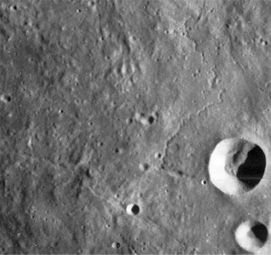
Credit: Lunar Orbiter view LO-IV-109H1.
Rim:
Ring:
Ring-dike Emplacement:
Rocks: See Rocks and Soils from the Moon.
To Top
S
Scalloped:
Scarp:
Secondary crater: See Crater Types.
Seismic: See also P-Waves, S-Waves and Moonquakes.

Credit: Adapted from Moon 101 (Pdf file) by Paul Spudis.
Selenographic:
Shield volcano: Example of lunar shield volcanoes can be seen in the series of Hortensius domes. See also Domes and Lunar Volcanoes, and an image of volcano types below. - JohnMoore2
Shock wave:
Siderophile:
Silica-rich:
Sill:
Simple crater: Simple craters usually take on a bowl-shape-like appearance. They are relatively small ranging in sizes from about 20 km-wide diameters and less. Their interior profiles are usually smooth having a gentle slope, and their rim crests are highly circular, with depth-to-diameter ratios at about 1:5. Example – Moltke crater. See also Transitional craters, Complex craters and Crater Types. - JohnMoore2
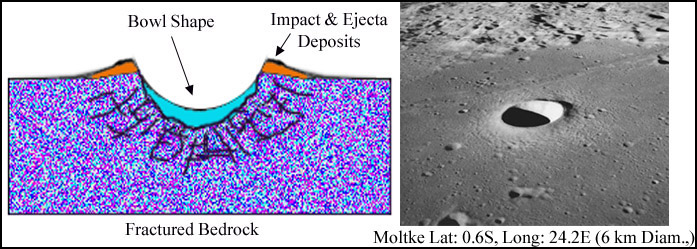
Credit: J. Moore, NASA (Photo).
Sinuous: A feature taking on a more wavey, curved, or bended shape. See also Sinuous rille above as an example.- JohnMoore2
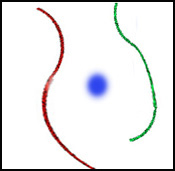
Credit: J. Moore
Slope:
Slumping:
South Pole Aitken (SPA) basin: (see SPA in MoonWiki).
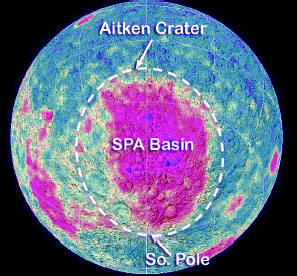
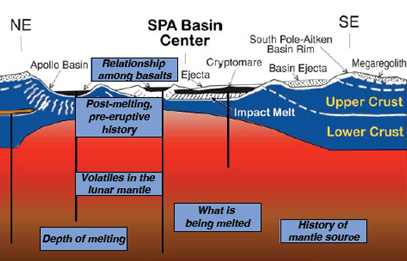
Credit: (Left) NASA, (Right) Adapted from Shearer (et al) paper - (see Bibliography below).
Spinel:
Steptoes: (see also Kipuka).
Strike-Slip (fault): When the direction of movement on the fault-plane is parallel to the strike of the fault. A Sinistral strike-slip fault is characterised when the lateral movement is left-ways, while a Dextral strike-slip is characterised when the lateral movement is rightways. As pointed out by Chuck Wood, Lambert R may be an example of a Strike-Slip fault (see LPOD 30 May 2010 ). See also Dip-Slip fault.- JohnMoore2

Credit: J. Moore. Photo: Stefan Lammel (annotated).
Subophitic: See Texture.
Superposition:
Stratigraphy: See Stratigraphy.
S-Waves:
Swell: See Domes and Lunar Volcanoes.
Swirls: See Swirls.
To Top
T
Target Rock:
Tectonic:
Terminal Lunar Cataclysm (TLC): First proposed by several scientists at the California Institute of Technology, USA, the TLC is believed to have been a cataclysmic event when most of the early impact-cratering on the Moon occurred around the same time as the Imbrium Basin formation 3.85 billion years ago (see also Stratigraphy). Determination of the absolute ages of various lunar features and lunar crustal viscosity measurements of major basins on the Moon suggest that the TLC may never have occurred. The proposed cataclysmic event was said to have occurred in a narrow time interval of ~ 2 x 10^8 years or less). See also research paper in bibliography below. - JohnMoore2
Texture:
- Aphanitic: A fine-grained, igneous rock whose crystal content can only be distinguished under the microscope – usually of a plagioclase feldspar makeup. See Apollo 17 sample (73235 – Pdf file ~2 Mb) of an aphanitic impact-melt breccia. The texture isn’t as glassy-like as those of the glass-type rocks, however, it does share a common relationship to volcanic origin where rapid cooling of the rock (melts) occurred. - JohnMoore2
- Cumulous:
- Granoblastic:
- Granulithic:
- Ophitic: An igneous type rock where plagioclase laths are completely enclosed by pyroxene (see subophitic below). Such textures are usually associated to igneous-like crystallization related to hot melts. - JohnMoore2
- Poikilitic: A rock where a number of smaller crystals are enclosed within a larger crystal. As an example, see Apollo 16 sample (65015 – Pdf file ~1.5 Mb) of a poikilitic impact melt breccia. The use of the term is usually confined to igneous rocks. Image below shows large subhedral pyroxene phenocrysts enclosing embayed olivine, ilmenite, and armalcolite crystals. Such textures are usually associated to igneous-like crystallization related to hot melts. - JohnMoore2
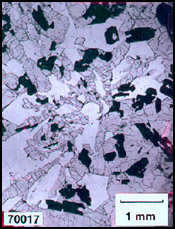
Credit: NASA.
- Porphyritic:
- Subophitic: Usually seen in igneous, basaltic and gabbroic type rocks where plagioclase laths are partly enclosed by pyroxene (see ophitic above). Such textures are usually associated to igneous-like crystallization related to hot melts. - JohnMoore2
- Vitrophyric: A porphyritic, igneous rock with large phenocrysts enclosed within a volcanic glassy rock.
Terrace:
Thorium:
Tilted crater: See Crater Types.
Ti-poor:
Ti-rich:
Transitional crater: A crater that looks like something between a simple type crater and a complex crater type crater. The typical bowl-like shape seen in the simple crater is missing because parts of the inner rim have slumped, or collapsed, into the central sector of this crater -- leaving behind a more flat floor. No central peak or terracing is seen. Example -- Bessel crater. See also Simple craters, Complex craters and Crater Types. - JohnMoore2
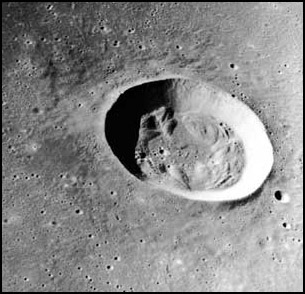
Credit: NASA
Troctolite: Feldspar with Olivine. Granulithic Troctolite sample 76535 from Apollo 17 shown below. Contains about 58% Plagioclase, 37% Olivine, and 4% Orthopyroxene. Compositional rocks like these are expected to have arisen through Igneous processes. - JohnMoore2
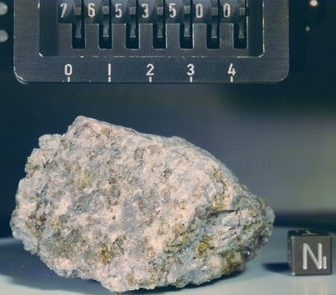
Credit: NASA
To Top
U
Upper (Early) Imbrium Period: 3.75 to 3.15 billion years ago. See Stratigraphy.
To Top
V
Vaporization:
Vesicles: Small holes or spaces that develop in a rock due to degassing of lava as it cools. Image below shows an Apollo 17 lunar sample with both vesicles easily visible, but larger cavities also are seen called Vugs. - JohnMoore2
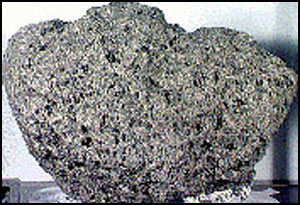 .
.
Credit NASA.
Viscosity:
Vitrophyric: See Texture.
Volatile:
Volcanic crater: See Crater Types and Volcano image below.
Vug: Small cavities in rocks that are slightly bigger than the Vesicles mentioned above. The vug in rocks may hold in place other minerals associated to the main rock’s formation, however, if these happen to be removed by, for example, erosional processes, the resultant cavity is left behind. - JohnMoore2
Volcano: See Lunar Volcanoes. Image below shows the different types of volcanoes on the Moon, with a view also of the Hortensius domes showing what appear to be possible calderas at their summits. - JohnMoore2

Credit: J. Moore and LROC (Photo).
To Top
W
Wall:
Wrinkle ridge:
To Top
X
Xenolith:
To Top
Y
To Top
Z
Zap Pits: An informal name given to the appearance of glassy-lined, micrometeoroid impact craters sometimes seen in lunar samples. See also Impact Phenomena of Micrometeorites on Lunar Surface Material in bibliography below. Image shows an Apollo 11 breccia sample (No. 10019). - JohnMoore2
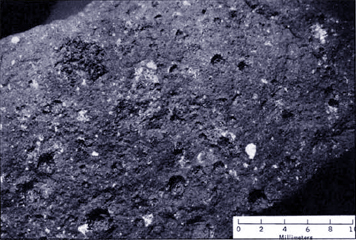
Credit: NASA photograph S-69-47905.
Zircon: Zircon (ZrSiO4) is a mineral of the orthosilicates (a class of silicate mineral in which SiO4 tetrahedra do not share oxygen atoms with each other) and is one of the most widely distributed accessory minerals in igneous and metamorphic rocks. Their role in radiometric dating of other rocks is important as trace amounts of uranium and Thorium can sometimes survive geologic processes such as high-grade metamorphism where rocks become re-melted and mixed. As a consequence, analyses of Zircon in lunar samples (e.g. taken during the Apollo missions) may hold clues as to why they dominate the nearside, and in their relation to the un-proved-as-yet Near Side Megabasin. Images below show (left) large rounded grains of zircon in lunar sample No. 73217, 16, (middle) a complex zircon known as “pomengranate” in lunar sample No. 73235, 82, while (right) shows thin section of lunar sample 73215. See also research paper in bibliography below. - JohnMoore2
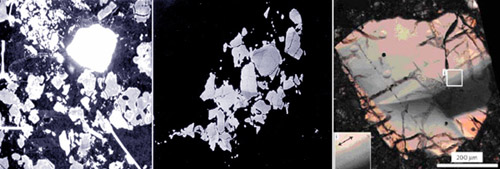 Credit: NASA (left and middle), Nemchin (right).
Credit: NASA (left and middle), Nemchin (right).
To Top
Additional Information
- Geologic Atlas of the Moon from the Lunar and Planetary Institute.
- Geology Map Downloads from the USGS.
- Selenology Today from the GLR group.
LPOD Articles
- Basinal Surprises
- Not Much Red
- The Unfamiliar Side of Orientale
- Colourful Pits
- DHC & Hidden Maria
- Blue Dots, White Rocks
- New Data, New Answers, New Mysteries
- Red Arrowhead
- Mascons and Masdefs
- Why Are Maria Where They Are
- Tectonic Targets
- Crater Systematics
- Cataloging Craters
- Looking Inside Rocks
- Moon 101
- Many Moons
- Circles Galore,
Bibliography
- Sato, H. et al (2017). Lunar mare TiO2 abundances estimated from UV/Vis reflectance - Icarus, Vol 296, 216-238, 1 Nov 2017. - JohnMoore2
- Saxena, P. et al (2017). A Model of the Primordial Lunar Atmosphere – Earth and Planetary Astrophysics, 22 Jun 2017. - JohnMoore2
- Lin, Y. et al (2016). Evidence for an early wet Moon from experimental crystallization of the lunar magma ocean – Nature Geoscience doi:10.1038/ngeo2845. Published online 28 Nov, 2016. - JohnMoore2
- Hejiu, H. et al (2013). Water in lunar anorthosites and evidence for a wet early Moon – Nature Geoscience Letter, Vol 6, No. 2. Published online 17 February 2013, DOI:10.1038/ngeo1735. 2013.
- Paniello, R. C. et al (2012). Zinc isotopic evidence for the origin of the Moon – Nature, Volume: 490, Pages: 376–379. Date published: (18 October 2012). DOI: 10.1038/nature11507. 2012.
- Canup. R. M. (2012). Forming a Moon with an Earth-Like Composition via a Giant Impact – Science DOI: 10.1126/science.1226073. 2012.
- Ćuk, M. and Stewart, S. T. (2012). Making the Moon from a Fast-Spinning Earth: A Giant Impact Followed by Resonant Despinning – Science DOI: 10.1126/science.1225542. 2012.
- Byrne, C. J. (2010). Absolute Zircon Ages for Pre-Nectarian Events and a Proposed Age for the Near Side Megabasin – NLSI Lunar Science Forum (July), 2010.
- Denevi, B. W. et al (2010). Physical Constraints on Impact Melt Properties from LROC NAC Images – NLSI Lunar Science Forum (July 2010), 2010.
- Glotch, T et al (2010). Diviner Observations of Lunar Swirls - NLSI Lunar Science Forum (July) 2010.
- Isaacson, P. et al (2010). Remote Compositional Analysis of Lunar Olivine with Moon Mineralogy Mapper (M3) Vis/NIR Reflectance Spectra – NLSI Lunar Science Forum (July), 2010.
- Kiely, C and Kiely, C.J. (2010). An X-ray Ultra microscopy Study of Apollo 11 Lunar Regolith - 41st Lunar and Planetary Science Conference (2010).
- Grange, M. L. et al (2009). Early History of the Moon: Zircon Perspective - 40th Lunar and Planetary Science Conference, 2009.
- Nemchin, A. A. and Pidgeon, R. T. (2008). Lunar Cataclysm or Lunar cataclysms? – 39th Lunar and Planetary Science Conference, 2008.
- Kramer, G. Y. et al (2008). Distinguishing high-alumina mare basalts using Clementine UVVIS and Lunar Prospector GRS data: Mare Moscoviense and Mare Nectaris - Journal of Geophysical Research, Vol 113, E01002. 2008.
- Spudis, P. D. (2008). Physiography and Geology of the Moon 2008.
- Shkuratov, Y. G. et al (2007) Lunar Surface Agglutinates: Mapping Composition Anomalies – Solar System Research (Journal) 10.1134/S003809460703001X, Vol 41, No.3, June 2007.
- Gustafson, R et al (2006). Development of a Lunar Agglutinate Simulant – Lunar and Planetary Institute Roundtable meeting. 2006.
- Hiesinger, H and Head (III), J. W. (2006). New Views of Lunar Geoscience: An introduction and Overview - Reviews in Mineralogy & Geochemistry Vol. 60, pp. XXX-XXX, 2006.
- Wood, C. A. (2003). The Modern Moon – A Personal View – Sky Publishing Corporation, 2003.
- Wilhelms, D. (1987). Geologic History of the Moon - US Geological Survey Professional Paper 1348, 1987.
- Wood, C. A. (1984). Calderas: A Planetary Perspective - Journal of Geophysical Research, Vol. 89, No. B10, PP. 8391-8406, 1984 doi:10.1029/JB089iB10p08391, 1984.
- Neukum, G. et al (1970) Impact Phenomena of Micrometeorites on Lunar Surface Material – Earth and Planetary Science Letters, Vol 8, Issue 1, March 1970, PP 31 – 35. 1970.
